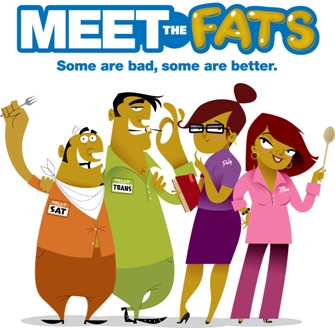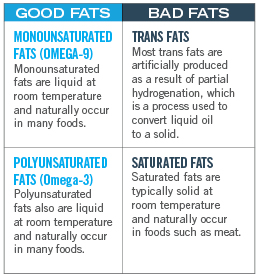 And that’s not a bad thing. It’s just a good thing to know. Why? Because it is a clue to what we should be eating to be healthy! Lots of people now know that eating some fat is a good thing and that while you could cut all fat out of your diet, it would be a really bad idea. What may still be controversial to a lot of people is the kind of fats that we should be eating. You’re about to read something that may challenge your belief about good vs. bad fats. This one’s a little long, so get ready.
And that’s not a bad thing. It’s just a good thing to know. Why? Because it is a clue to what we should be eating to be healthy! Lots of people now know that eating some fat is a good thing and that while you could cut all fat out of your diet, it would be a really bad idea. What may still be controversial to a lot of people is the kind of fats that we should be eating. You’re about to read something that may challenge your belief about good vs. bad fats. This one’s a little long, so get ready.
For the majority of human history nearly all fats came from animals. Period. Some groups had access to seasonal nuts, but for the majority, eating fat meant eating animal fat. So let’s start with that animal fat is what got us here. Something else you may not know is that the composition of fat in the human body is mostly saturated and mono-unsaturated fat. Only about 4% of the human body is made up of poly-unsaturated fat. Let’s create the hypothesis that if you are made up of a certain kind of fat, you should consume that type of fat to support the continued maintenance of those tissues. Another unfortunate fact is that most poly-unsaturated fats made from vegetable sources are rancid. They become rancid when heated, and commercial vegetable oils are heated to be processed. That means they are rancid off the shelf. The important thing about rancidity is the presence of free radicals, molecules that attack cell membranes and red blood cells. This is why cold-pressed olive oil is so valuable.
 When choosing which fats to consume or cook in, you want to consider that there are good fats that you may not be using or are still a little afraid of. There are lots of good reasons to eat saturated fats:
When choosing which fats to consume or cook in, you want to consider that there are good fats that you may not be using or are still a little afraid of. There are lots of good reasons to eat saturated fats:
-
Your heart will love you back. Saturated fat reduces the presence of lipoprotein (a) (pronounced lipoprotein “little a”), a substance strongly associated with cardiovascular health risk. There is currently no medication to lower it.
-
Bone up! Saturated fat is required for calcium to be incorporated into bones. Look around and wonder about the levels of osteoporosis in the current dietary environment and consider the fats that people are told most to eat.
-
Don’t end up as foie gras. It helps the liver clear fat stores, helping reduce middle-of-the-body fat stores. It also helps protect the liver from toxic substances like alcohol and medication. Poly-unsaturated fat does not.
-
Healthy lungs! The entire surface of your lungs is coated with a substance called surfectant, which is made entirely of saturated fatty acids. No saturated fat, faulty surfectanct. Faulty surfectanct can lead to airspace collapse.
-
More brains (the zombie’s will love you)! Your brain is made up entirely of cholesterol and fat. The majority of the fatty acids are saturated. Skimp on the raw materials and you skimp on the final product.
-
Nature’s wireless. Your nerve signalling is dependent on saturated fats — especially those in coconut oil, butter, lard, and palm oil. Without them, your brain can’t effectively tell your body what to do.
-
Invincibility! Loss of saturated fatty acids in white blood cells hampers their ability to recognize threats like viruses and bacteria.
So what should you eat?
-
Butter from pastured animals
-
Lard from foraging pigs
-
Coconut oil
-
Cold-pressed olive oil
-
Free range duck or goose fat or beef tallow
What shouldn’t you eat?
-
Commercially produced poly-unsaturated fats (corn, soy, canola oil, margarine)
-
Saturated or mono-unsaturated fats from industrially-raised animals (that means butter, lard, egg yolks, milk, farmed fish)
One of the primary reasons to avoid the “shouldn’ts” is the ratio of omega-6 fatty acids to omega-3. This isn’t something that we covered in this blog, but I will cover in a future blog post. Suffice it to say, omega-6 is not bad, but it is only not bad when it is in proper balance with omega-3. For the most part, our industrialized diet is very high in omega-6 fatty acid, the primary reason we supplement so heavily with omega-3. A ratio of omega-6 to omega-3 that doesn’t promote ill health is 4-to-1 or lower. Our diet can have ratios as high as 40-to-1, a recipe for metabolic disaster.
Thanks to Dr. Michael Eades for the section above on saturated fat. Originally posted on June 6, 2009 on the blog of The Four Hour Workweek.


